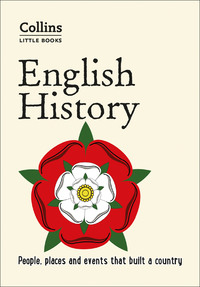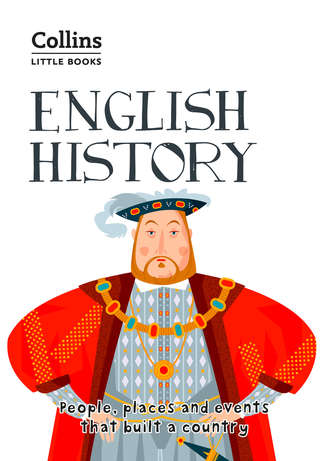
Полная версия
English History: People, places and events that built a country


Copyright
HarperCollins Publishers
Westerhill Road
Bishopbriggs
Glasgow
G64 2QT
First Edition 2018
© HarperCollins Publishers 2018
Collins® is a registered trademark of HarperCollins Publishers Limited
www.collins.co.uk
A catalogue record for this book is available from the British Library
Author: Robert Peal
All rights reserved under International and Pan-American Copyright Conventions. By payment of the required fees, you have been granted the non-exclusive, non-transferable right to access and read the text of this e-book on screen. No part of this text may be reproduced, transmitted, downloaded, decompiled, reverse engineered, or stored in or introduced into any information storage and retrieval system, in any form or by any means, whether electronic or mechanical, now known or hereafter invented, without the express written permission of HarperCollins.
HarperCollins does not warrant that www.collins.co.uk or any other website mentioned in this title will be provided uninterrupted, that any website will be error free, that defects will be corrected, or that the website or the server that makes it available are free of viruses or bugs. For full terms and conditions please refer to the site terms provided on the website.
Source ISBN: 9780008298135
Ebook Edition © July 2018 ISBN: 9780008306526
Version 2018-08-03
HarperCollinsPublishers has made every reasonable effort to ensure that any picture content and written content in this ebook has been included or removed in accordance with the contractual and technological constraints in operation at the time of publication.
Contents
Cover
Title Page
Copyright
Introduction
English History
10,000 BC | Prehistoric England
3,000 BC | Stonehenge
AD 43 | The Romans
AD 61 | Boudicca
410 | Legend of King Arthur
400s | Anglo-Saxons
597 | The Arrival of Christianity
793 | Viking Raids
899 | Alfred the Great
937 | Rex Angloram
1042 | Edward the Confessor
1066 | King Harold
1066 | Battle of Hastings
1060s and 70s | Norman Conquest
1086 | Domesday Book
1170 | Murder of Thomas Becket
1204 | Eleanor of Aquitaine
1215 | King John and the Magna Carta
1200s | Robin Hood
1265 | The first Parliament
1283 | The Conquest of Wales
1337 | The Hundred Years War
1348 | Order of the Garter
1348 | The Black Death
1381 | The Peasants’ Revolt
1387 | The Canterbury Tales
1415 | Agincourt
1459 | The Wars of the Roses
1483 | The Princes in the Tower
1485 | The Battle of Bosworth Field
1509 | Henry VIII
1534 | Anne Boleyn
1534 | The English Reformation
1547 | Henry VIII’s death
1553 | Mary I and the Counter-Reformation
1558 | Elizabeth I
1580 | Sir Francis Drake
1587 | Mary Queen of Scots
1588 | The Spanish Armada
1590 | Shakespeare
1603 | King James VI and I
1605 | The Gunpowder Plot
1629 | Charles I and Parliament
1642 | The English Civil War
1649 | Regicide
1649 | Cromwell’s Commonwealth
1660| Restoration
1666 | Great Fire of London
1687 | Sir Isaac Newton
1688 | The Glorious Revolution
1707 | The Act of Union
1714 | The House of Hanover
1721 | Britain’s First Prime Minister
1739 | Highwaymen
1740 | Rule, Britannia!
1745 | Jacobite Uprising
1755 | Dr Johnson’s Dictionary
1763 | The Seven Years War
1700s | Food and Empire
1770 | Captain Cook and Australia
1772 | The Slave Trade
1775 | Britain’s First Factories
1776 | American Revolution
1776 | Steam Engine
1788 | Mad King George
1791 | Rights of Man
1805 | The Battle of Trafalgar
1813 | Jane Austen
1815 | Duke of Wellington
1829 | The Metropolitan Police Force
1830 | The Railway Age
1833 | Child Labour
1833 | Abolition of the Slave Trade
1837 | Queen Victoria
1846 | The Workhouse
1851 | Industrial Cities
1851 | The Great Exhibition
1854 | Florence Nightingale
1859 | On the Origin of Species
1859 | Brunel
1859 | Big Ben
1863 | Association Football
1870 | Charles Dickens
1888 | Jack the Ripper
1899 | The Boer War
1912 | Titanic
1913 | Emily Davison
1914 | The First World War
1916 | The First Day of the Somme
1918 | Armistice Day
1922 | The BBC
1926 | General Strike
1936 | Abdication
1940 | Dunkirk
1940 | The Battle of Britain
1941 | The Home Front
1945 | VE Day
1948 | The NHS
1948 | The Empire Windrush
1953 | Coronation of Queen Elizabeth II
1956 | Suez Crisis
1966 | World Cup Win
1960s | Beatlemania
1979 | Thatcher Becomes Prime Minister
1989 | Invention of the World Wide Web
1994 | Opening of the Channel Tunnel
1997 | Death of Princess Diana
1997 | Harry Potter
2012 | London Olympics
2016 | Brexit
Conclusion
Index
About the Publisher
Introduction
‘This royal throne of kings, this scepter’d isle… This precious stone set in the silver sea… This blessed plot, this earth, this realm, this England’
William Shakespeare, Richard II
In his paean to England in Shakespeare’s Richard II, John of Gaunt emphasises the importance of England’s status as an ‘island nation’. He is right to do so. So much of England’s history has been dictated by its position on a small, rainy island off the western coast of Europe.
England’s early history saw its shores invaded by waves of foreign settlers. The Romans arrived with Julius Caesar, followed by the Anglo-Saxons, the Vikings, and finally the Normans in 1066. This has given England an unusual mixture of Latin, French and Germanic influences. Days of the week in English are named after Norse Gods, but the months have Roman origins. The structure of the English language comes from Germany, but much of its vocabulary from France.
England’s status as an island nation has offered it unrivalled defences against foreign invaders, such as Phillip II of Spain in 1588, Napoleon Bonaparte in 1805, and Adolf Hitler in 1940. Unless you count the peaceful invasion of William and Mary in 1688, England has not been successfully invaded for one thousand years. The natural protection of the seas has given English history a stability and continuity that is unusual amongst the nations of Europe. The English Parliament has been meeting in Westminster since the 13th century, and the last battle fought on British soil was the defeat of Bonnie Prince Charlie at the Battle of Culloden in 1746.
England always depended upon its navy more than its army for protection, and for this reason the English people have long celebrated sailors as national heroes, such as Sir Francis Drake, Sir Walter Raleigh, Captain Cook and Lord Nelson. Britain’s seafaring tradition came into its own when the countries of Europe began building global empires. From the mid-18th century onwards, the Royal Navy lay behind Britain’s emergence as a world superpower, building an Empire stretching across North America, Africa, Asia and Australia. Today, Britain’s multi-racial society with large Caribbean, Pakistani, Bangladeshi, Chinese and Indian populations is a direct legacy of its time as a sea-faring Empire.
Any book on the history of England will encounter difficulty negotiating England’s appearance, and then disappearance, as a single political unit. England only emerged as one country, governed by one ruler, during the reign of Alfred the Great’s grandson, King Athelstan. If you were to pinpoint England’s birthdate, then King Athelstan’s victory against the Vikings at the Battle of Brunanburh in ad 937 is perhaps the best contender. For this reason, this book gives relatively brief treatment to the history of ‘England’ prior to 937, offering a brief outline of the prehistoric, Roman, and early Anglo-Saxon periods in order to set the scene for England’s emergence during the 10th century.
England’s status as a sovereign state ended in 1707, when the Act of Union fused England and Wales with Scotland to form a new nation: Great Britain. From this point onwards in the book, I cease to write so often of ‘England’, as so many actions – in particular the creation of a global Empire – were really carried out by Britain. However, even though England ceased to be a sovereign state in 1707, it remains a country, with distinct traditions, culture, and – perhaps most importantly! – international sports.

10,000 BC | Prehistoric England
Around 12,000 years ago, the last Ice Age ended, and the British Isles once again became inhabited by humans. No written records of life in England exist from before the Roman invasion in 55 BC, so prehistoric England is a mysterious and unknowable place. But prehistoric Britons did leave their mark in other ways. Some lived in earthwork defensive settlements such as Maiden Castle in Dorset, some left behind enormous burial mounds for the dead. Prehistoric Britons were also skilled metalworkers, creating beautiful jewellery out of twisted gold thread. Tribal leaders would wear a thick golden ring called a ‘torc’ around their neck. There are also the remains of up to 900 stone circles built by prehistoric Britons, thought to have been used for religious and ceremonial purposes.
The warrior culture in prehistoric Britain can be seen from the swords, spears, shields and helmets uncovered by archaeologists. We also know that warriors rode horses and used chariots for battle. Two of the greatest artefacts uncovered dating from this period were found in the River Thames in London: a ceremonial bronze horned helmet found beside Waterloo Bridge, and a beautiful ceremonial shield decorated with coloured red glass, which was found in the Thames at Battersea.

Jason Benz Bennee
3,000 BC | Stonehenge
The most famous monument from prehistoric England is Stonehenge in Wiltshire. The first stage of its construction began in 3,000 bc, and it originally consisted of eighty-two stones arranged in two rings. Extraordinarily, these stones – which weighed up to four tonnes each – are thought to have been dragged to Wiltshire all the way from South Wales. Most of Stonehenge as we see it today was constructed from stones brought from 19 miles away in the Marlborough Downs. The heaviest stone weighs fifty tonnes, and would have required 500 people to drag it on rollers and sledges to Stonehenge.
Inside Stonehenge, archaeologists have uncovered pits containing pieces of flint and red clay, probably used as religious offerings. Some of these pits contained the cremated remains of people. In addition, there are numerous Bronze Age burial mounds nearby, often placed on high ground overlooking the monument. Stonehenge was clearly a site of great religious and ceremonial importance, perhaps used for funeral ceremonies. Some archaeologists believe Stonehenge was used to observe the movements of the sun and the moon, with special ceremonies held at the monument on the Summer and Winter solstices (the longest and shortest days of the year).
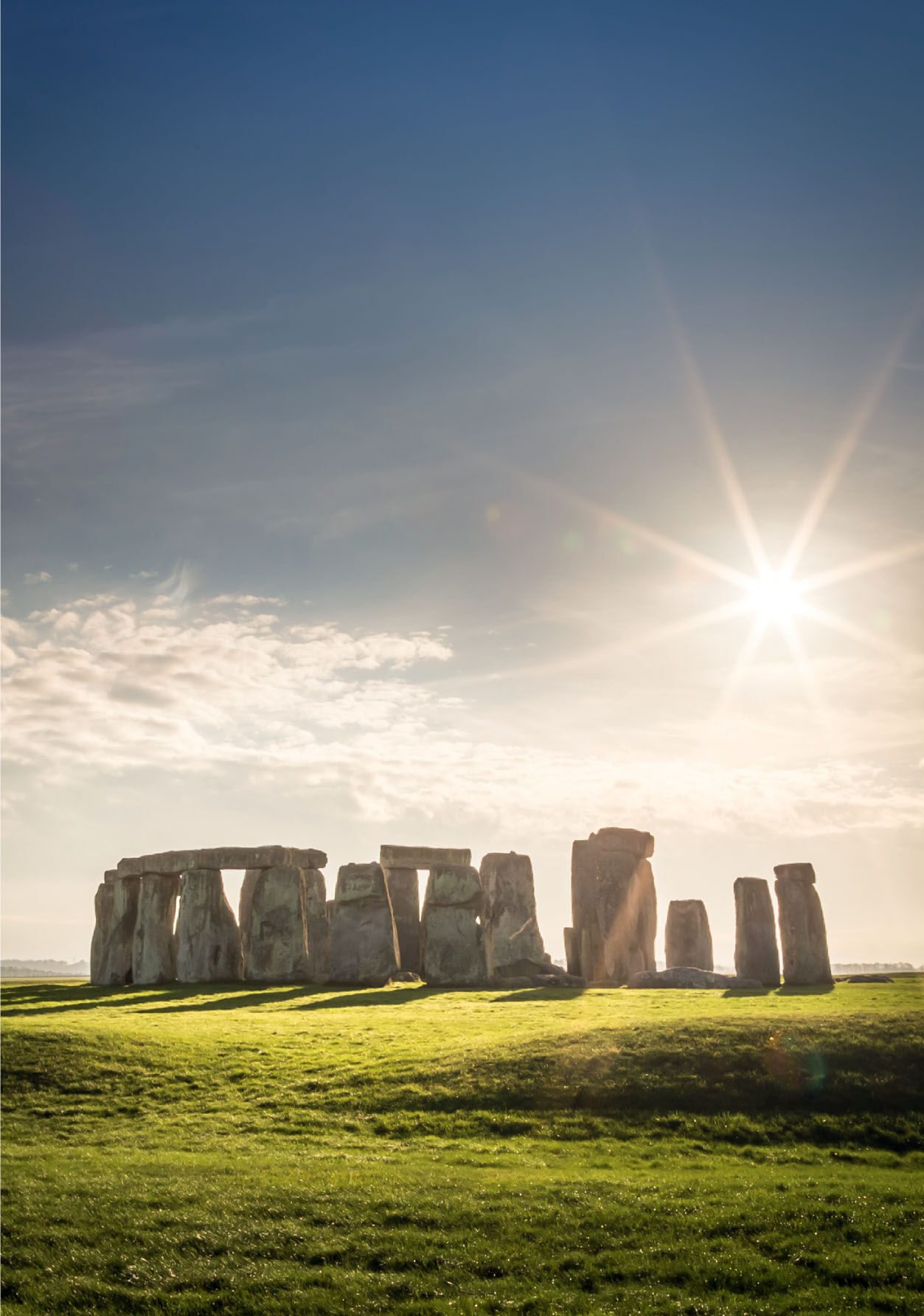
Kevin Lavorgna
AD 43 | The Romans
By the 1st century bc, Roman civilisation was reaching its zenith, and the Roman Empire spread across Western Europe to the Middle East and North Africa. Meanwhile, Britain remained a prehistoric civilisation, inhabited by a people sometimes referred to today as ‘Celts’. The first Roman to lead an expedition to Britain was the Governor of Gaul, Julius Caesar. In 54 BC, Caesar invaded Britain with an army of around 37,000 troops and won the surrender of its Southern tribes. However, Caesar had to return to Italy, and his conquest of Britain was left incomplete.
A century later in AD 43, the Roman Emperor Claudius set his sights on conquering Britain, in part to gain possession of its wealthy gold, silver and tin mines. An invasion force of 40,000 Roman soldiers landed in Britain, which Emperor Claudius later joined with a force of elephants – intended to scare the Britons into submission! For the next four centuries, Roman power spread across England and Wales, all the way to Hadrian’s Wall near today’s border with Scotland. Some remains of Roman rule can be seen today in locations such as Fishbourne Palace in West Sussex, Porchester Castle in Hampshire, and the beautiful Roman baths in Bath.
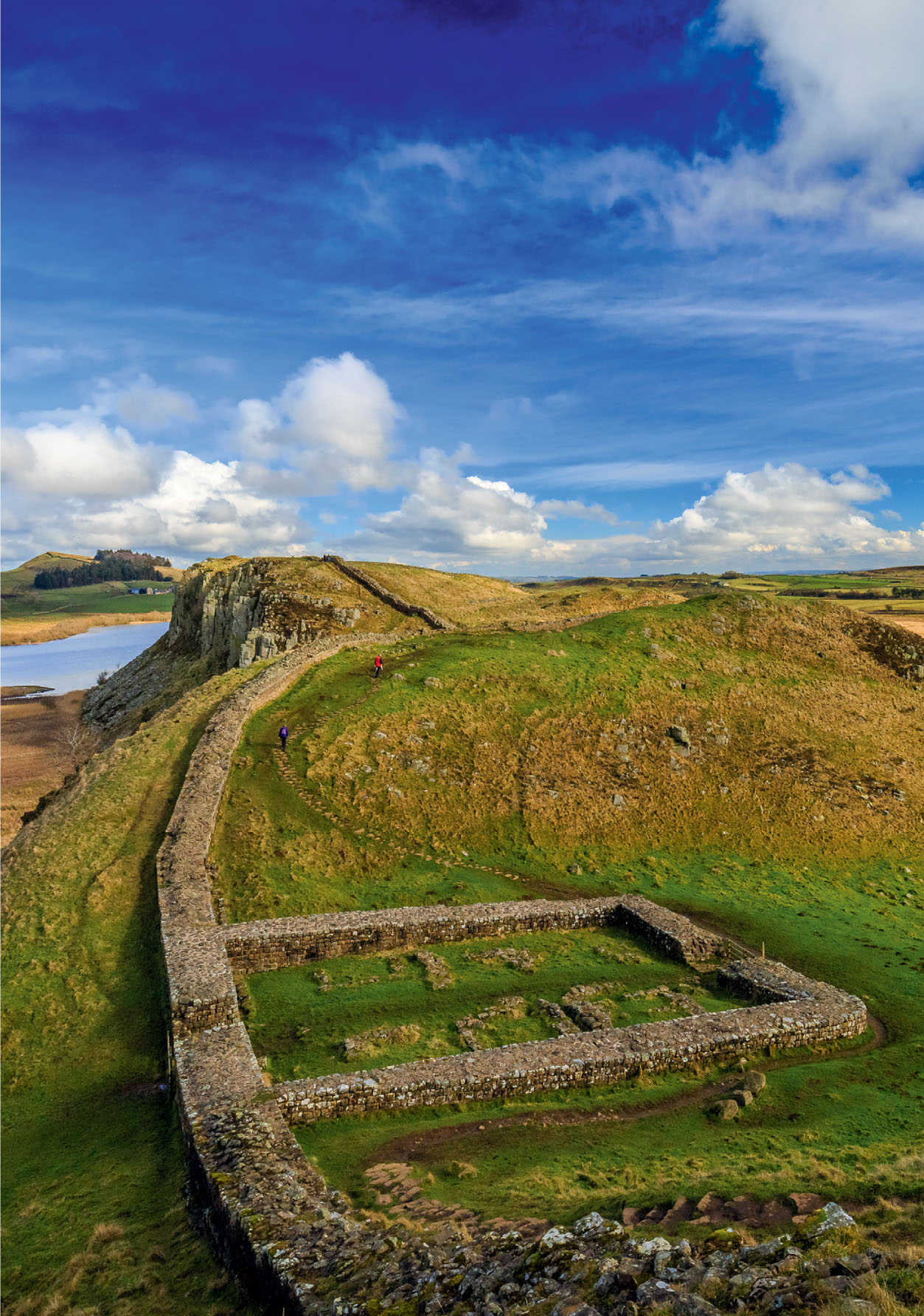
Michael Conrad
AD 61 | Boudicca
It was only during the 16th century that the story of Boudicca, the famous warrior queen, was uncovered in the writings of the Roman historian Tacitus. Boudicca was the Queen of the Iceni tribe in modern-day Norfolk. The invading Romans were unwilling to respect the authority of a female leader, so they confiscated Boudicca’s land, publically beat her, and – worst of all – raped her two daughters. Boudicca was outraged, and her Iceni tribe rose up in rebellion, destroying the nearby Roman capital of Camulodonum (Colchester). Boudicca and her rebel army then burnt to the ground the Roman trading settlement of Londinium (London), before turning northwards, and destroying the Roman settlement of Verulamium (St Albans).
According to Roman historians, Boudicca was tall and fierce, with a mass of tawny hair flowing down to her hips. Tribes flocked from across southern Britain to join their defiant warrior queen. Boudicca’s final showdown with the Roman army took place somewhere in the Midlands, but the well-drilled Roman army was too much for the Britons. They were massacred, and Boudicca and her daughters poisoned themselves rather than falling into the hands of the Roman soldiers. With Boudicca’s rebellion defeated, the Roman conquest could now continue.

Claudio Divizia / shutterstock.com
410 | Legend of King Arthur
By the 5th century, Rome was under attack from the barbarian tribes of northern Europe. In 410, the Roman Emperor ordered Roman legions stationed in Britain to abandon the country and return to Rome to help in the city’s defence. A small population of Romano-British citizens were left in Britain, but they were unable to defend themselves from a new invasion force from Northern Germany attacking Britain’s shores – the Anglo-Saxons.
It was from this tumultuous period of history that England’s most potent legend emerged: the tale of King Arthur. If he existed at all, King Arthur may have been a Romano-British military ruler who led the defence of Britain against invading Anglo-Saxons during the 5th century. However, over the centuries medieval poets, artists and storytellers added layers of myth and legend to this outline, keen to reshape Arthur in their own image. Arthur’s story was embellished by the wizard Merlin, Arthur’s wife Guinevere, the gallant knight Sir Lancelot, and the legend of the Sword in the Stone – none of which has any grounding in historical records. Even Arthur’s Round Table, which can be visited in Winchester Castle, was created around 1290 during the reign of Edward I.
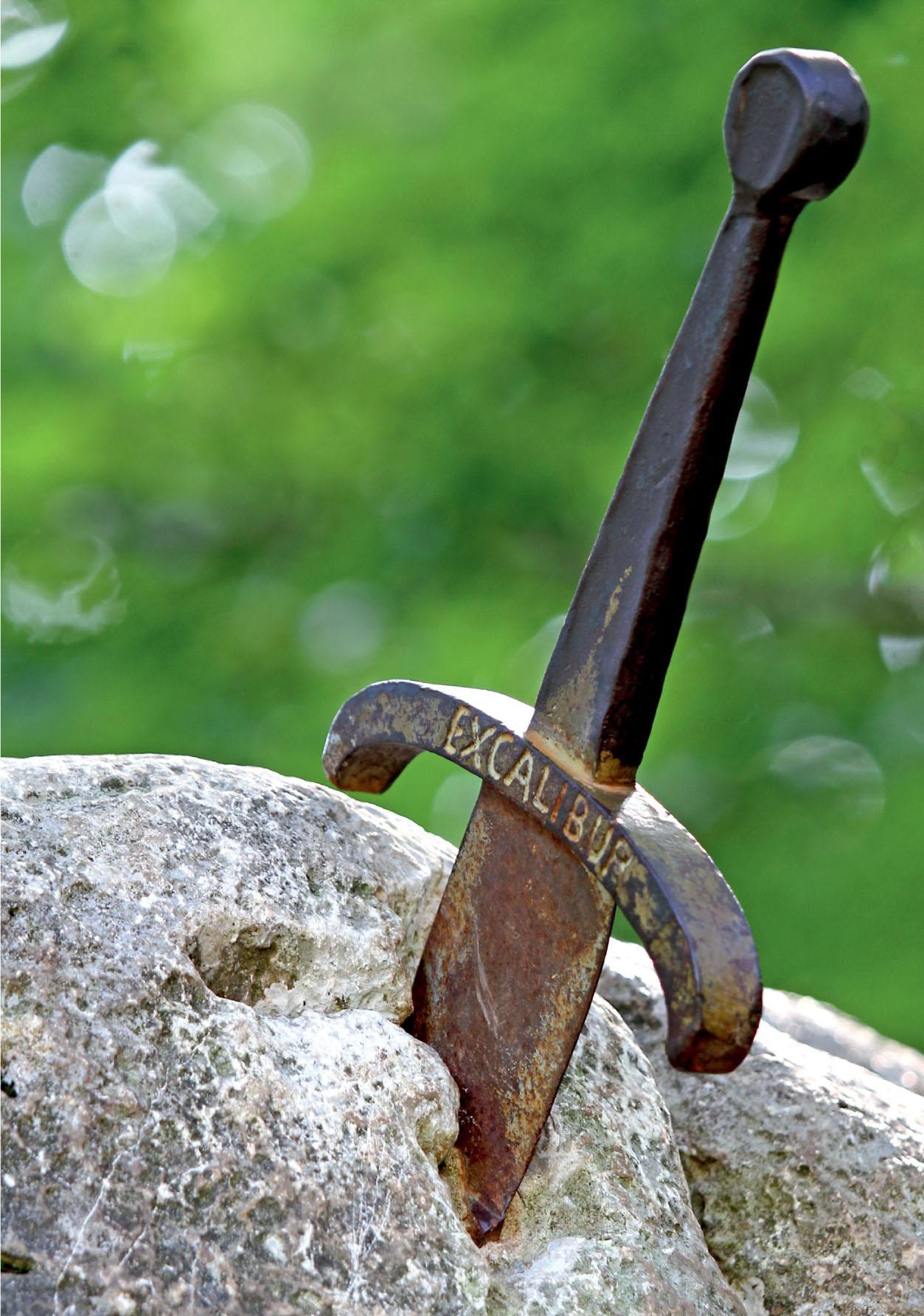
ChiccoDodiFC
400S | Anglo-Saxons
After the Roman army abandoned Britain in 410, two tribes from Northern Germany began to invade and settle in England. Known as the Anglo-Saxons, they established a number of separate kingdoms across the country, such as Wessex in the south, Mercia in the midlands, and Northumbria in the Northeast. Early Anglo-Saxon England had a population of perhaps one million people living scattered across the countryside, in houses made of wood and straw.
Unlike the Romans, the early Anglo-Saxons could not read or write, and did not have the technology to build cities or roads. There are no written records or buildings left from this period for historians to study, so some call the early Anglo-Saxon period the ‘Dark Ages’. Much of what we know about early Anglo-Saxon England comes from the findings of archaeologists. Anglo-Saxons were skilled metal workers who loved jewellery and made beautiful objects out of gold and gems. Perhaps the most famous Anglo-Saxon artefact is an iron helmet and patterned facemask found in 1939 at a burial mound in Suffolk called Sutton Hoo. The Sutton Hoo helmet was intricately decorated with scenes of war, such as a warrior on a horse trampling a fallen enemy.
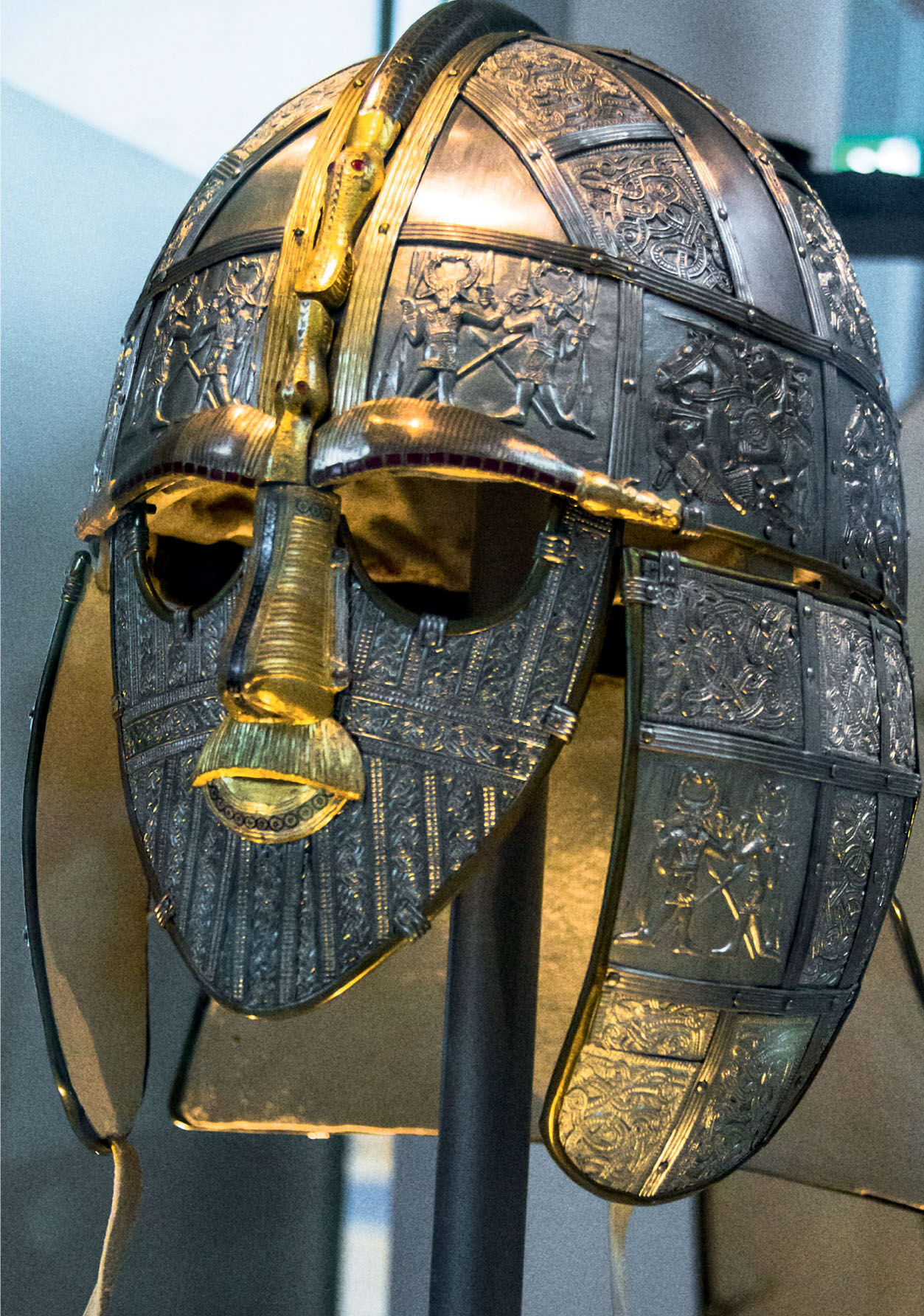
Flik47 / shutterstock.com
597 | The arrival of Christianity
At first, the Anglo-Saxons were pagans, who believed in the Norse gods. Woden was the King of the Gods, but there was also Tiw the god of war, Freya the goddess of love and fertility, and Thor the god of thunder. The days of the week in English are still named after these gods: Tiw became Tuesday, Woden became Wednesday, Thor became Thursday, and Freya became Friday.
This began to change when Pope Gregory in Rome sent a monk named Augustine to convert the Anglo-Saxons to Christianity. Augustine landed on the south coast of England in 597 with a group of around forty monks. Here, Augustine met Ethelbert, the King of Kent. Ethelbert’s wife, a princess from France called Bertha, was already a Christian. Under Bertha and Augustine’s influence, Ethelbert became the first Anglo-Saxon king to convert to Christianity. In 635, a monk called Aidan brought Christianity to Northumbria from Ireland. Pope Gregory made Augustine the first Archbishop of Canterbury, and Kent and Northumbria became the centres of Christianity in England, from which this new religion eventually spread throughout the whole country. To this day, the Archbishop of Canterbury remains the leader of the Church of England.
793 | Viking raids
In January 793, a band of warriors attacked the Christian monastery on the Holy Island of Lindisfarne in Northumbria. They arrived from the sea in ships with dragon heads carved into the bows, heavily armed with metal helmets, armour and two-handed axes. The warriors broke into the monastery, drowning the older monks in the sea and taking the younger monks as slaves. They then stole Lindisfarne’s treasures, and sailed away.
For the next three centuries, Anglo-Saxon England was subject to repeated waves of attacks from these warriors. Known as Vikings, they sailed to Britain from Scandinavia in longboats – huge ships that used both oars and sails to travel great distances along rivers and across the seas. At first, Vikings were content with hit-and-run raids on English coastal towns and monasteries. However, in 865, the Vikings assembled a force to settle in England, known as the ‘Great Heathen Army’. The Great Heathen Army captured the city of York in 867, and used it as a base to spread their power throughout northern England. Known as ‘Jorvik’ to the Vikings, York became a thriving centre of overseas trade under Viking rule, and home to perhaps 15,000 people.
899 | Alfred the Great
Alfred became King of Wessex, an Anglo-Saxon kingdom in the south of England, in 871. Aged only 23, he was immediately thrown into the long-running war with the Viking Great Heathen Army, who had by now settled throughout much of England. In 878, a Viking army led by King Guthram attacked King Alfred in Chippenham while he was celebrating Twelfth Night, the last day of Christmas. Alfred escaped the attack, but many of his men were slaughtered. Almost defeated, Alfred retreated to the marshes of Somerset, where he began to organise his counter-attack. Later that year, Alfred defeated Guthram’s Vikings at the Battle of Edington.
Alfred and Guthrum agreed to divide England by a diagonal line from the mouth of the River Mersey in the north-west, to the mouth of the Thames in the south-east. Alfred ruled the land to the south of this line, and fortified it against any future Viking attacks. In 899, Alfred died. His defeat of the Vikings, and rule of Wessex laid the foundation on which his descendants would build the unified Anglo-Saxon Kingdom of England. Today, Alfred remains the only king in English history to be remembered as ‘the Great’.

Awe Inspiring Images
937 | Rex Angloram
Following King Alfred’s death in 899, it fell to his son King Edward the Elder to continue the fight against the Vikings. Edward was greatly helped by his older sister Æthelflæd, who ruled much of the English Midlands as the ‘Lady of Mercia’. Famed for her intelligence and strength, Æthelflæd led her armies into battle against the Vikings, winning back their land for the Anglo-Saxons. King Edward was so impressed by his tough older sister Æthelflaed that he sent his own son, Athelstan, to be brought up by her.





